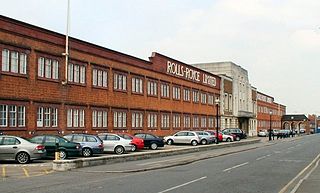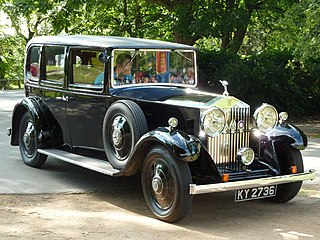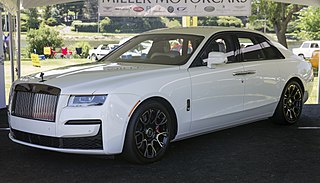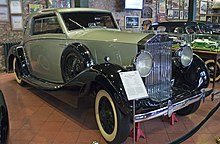
The Rolls-Royce Silver Cloud is a luxury automobile produced by Rolls-Royce Limited from April 1955 to March 1966. It was the core model of the Rolls-Royce range during that period. The Silver Cloud replaced the Silver Dawn and was, in turn, replaced by the Silver Shadow. The John P. Blatchley design was a major change from the pre-war models and the highly derivative Silver Dawn. As part of a range rationalisation, the Bentley S1 was made essentially identical, apart from its radiator grille and badging.

The Rolls-Royce Silver Shadow is a full-size luxury car produced by British automaker Rolls-Royce in various forms from 1965 to 1980. It was the first of the marque to use unitary body and chassis construction.

The Rolls-Royce Silver Dawn is a full-size luxury car that was produced by Rolls-Royce at their Crewe works between 1949 and 1955. It was the first Rolls-Royce car to be offered with a factory built body which it shared, along with its chassis, with the Bentley Mark VI until 1952 and then the Bentley R Type until production finished in 1955. The car was first introduced as an export only model. The left hand drive manual transmission models had a column gear change, while right hand drives had a floor change by the door. In the British home market the Silver Dawn only became available from October 1953, with the introduction of the model corresponding to the Bentley R Type.

The Rolls-Royce Silver Ghost name refers both to a car model and one specific car from that series. Originally named the "40/50 h.p." the chassis was first made at Royce's Manchester works, with production moving to Derby in July 1908, and also, between 1921 and 1926, in Springfield, Massachusetts, USA. Chassis no. 60551, registered AX 201, was the car that was originally given the name "Silver Ghost". Other 40/50 hp cars were also given names, but the Silver Ghost title was taken up by the press, and soon all 40/50s were called by the name, a fact not officially recognised by Rolls-Royce until 1925, when the Phantom range was launched.

The Bentley Mark VI is an automobile from Bentley which was produced from 1946 until 1952.

The Bentley R Type is the second series of post-war Bentley automobiles, replacing the Mark VI. Essentially a larger-boot version of the Mk VI, the R type is regarded by some as a stop-gap before the introduction of the S series cars in 1955. As with its predecessor, a standard body was available as well as coachbuilt versions by firms including H. J. Mulliner & Co., Park Ward, Harold Radford, Freestone and Webb, Carrosserie Worblaufen and others.

The Silver Wraith was the first post-war Rolls-Royce. It was made from 1946 to 1958 as only a chassis at the company's Crewe factory, its former Merlin engine plant, alongside the shorter Bentley Mark VI. The Bentley was also available as a chassis for coachbuilders, but for the first time could be bought with a Rolls-Royce built Standard Steel body. The use of the name "wraith" coincided with the established tradition of naming models after "ghosts".

The Rolls-Royce Phantom IV is a British automobile produced by Rolls-Royce. Only eighteen were made between 1950 and 1956, sold only to buyers whom Rolls-Royce considered worthy of the distinction: the British royal family and heads of state. Sixteen are known to still exist in museums as well as in public and private collections.

The Rolls-Royce Corniche is a two-door, front-engine, rear wheel drive luxury car produced by Rolls-Royce Motors as a hardtop coupé and as a convertible.

The Rolls-Royce Phantom III was the final large pre-war Rolls-Royce. Introduced in 1936, it replaced the Phantom II and it was the only V12 Rolls-Royce until the 1998 introduction of the Silver Seraph. It is the first of the three V12-powered Rolls-Royce Phantoms, with the 2003-2017 Rolls-Royce Phantom VII and 2018- Rolls-Royce Phantom VIII being the other two. 727 V12 Phantom III chassis were constructed from 1936 to 1939, and approximately 650 have survived. Although chassis production ceased in 1939, cars were still being bodied and delivered in 1940 and 1941. The last car, though the rolling chassis was completed in 1941, was not delivered with a body to its owner until 1947. The Phantom III was the last car that Henry Royce worked on – he died, aged 70, a year into the Phantom III's development.

The Bentley 3½ Litre was presented to the public in September 1933, shortly after the death of Henry Royce, and was the first new Bentley model following Rolls-Royce's acquisition of the Bentley brand in 1931.

The Bentley Mark V was Rolls-Royce's second Bentley model. Intended for announcement at the Earl's Court Motor Show set down for late October 1939 it had much in common with its predecessor. War was declared on 3 September 1939 and a few days later Bentley announced it had ceased production of civilian items.

The Bentley 8 Litre was a large inline 6-cylinder super-luxury car made in various configurations by Bentley Motors Limited at Cricklewood, London. Announced 15 September 1930, it was also the last completely new model by Bentley before the company's financial collapse and forced sale to Rolls-Royce Limited.

The Rolls-Royce 10 hp was the first car to be produced as a result of an agreement of 23 December 1904 between Charles Rolls and Henry Royce, and badged as a Rolls-Royce. The 10 hp was produced by Royce's company, Royce Ltd., at its factory in Cooke Street, Hulme, Manchester, and was sold exclusively by Rolls' motor dealership, C.S.Rolls & Co., at a price of £395. The 10 hp was exhibited at the Paris Salon in December 1904, along with 15 hp and 20 hp cars and engine for the 30 hp models.

Rolls-Royce Limited was a British luxury car and later an aero-engine manufacturing business established in 1904 in Manchester by the partnership of Charles Rolls and Henry Royce. Building on Royce's good reputation established with his cranes, they quickly developed a reputation for superior engineering by manufacturing the "best car in the world". The business was incorporated as "Rolls-Royce Limited" in 1906, and a new factory in Derby was opened in 1908. The First World War brought the company into manufacturing aero-engines. Joint development of jet engines began in 1940, and they entered production in 1944. Rolls-Royce has since built an enduring reputation for the development and manufacturing of engines for military and commercial aircraft.

The Rolls-Royce 20/25 was the second of Rolls-Royce Ltd's pre-war entry level models. Built between 1929 and 1936, it was tremendously popular, becoming the most successful selling inter-war Rolls-Royce. Its success enabled Rolls-Royce to survive the economic difficulties of the Great Depression years and remain one of world's great brands. A total of 3,827 20/25s were produced, of which over 70% are still on the road today.

The Rolls-Royce Twenty built between 1922 and 1929 was Rolls-Royce's "small car" for the 1920s and was produced alongside the 40/50 Silver Ghost and the successor to the 40/50, the Phantom. It was intended to appeal to owner-drivers but many were sold to customers with chauffeurs.

The Rolls-Royce 30 hp was one of four cars to be produced as a result of an agreement of 23 December 1904 between Charles Rolls and Henry Royce. Badged as a Rolls-Royce, the 30 hp was produced during 1905 and 1906 by Royce's company, Royce Ltd. at its factory in Cooke Street, Hulme, Manchester. It was sold exclusively by Rolls' motor dealership, C.S.Rolls & Co., at a price of GBP 890. The engine was exhibited at the Paris Salon in December 1904, along with the 10 hp, 15 hp and 20 hp models.

The Rolls-Royce Ghost is a full-sized luxury car manufactured by Rolls-Royce Motor Cars. The "Ghost" nameplate, named in honour of the Silver Ghost, a car first produced in 1906, was announced in April 2009 at the Auto Shanghai show. The production model was officially unveiled at the 2009 Frankfurt Motor Show. The Ghost Extended Wheelbase was introduced in 2011. During development, the Ghost was known as the "RR04". It was designed as a smaller, "more measured, more realistic car" than the Phantom, aiming for a lower price category for Rolls-Royce models.

The Rolls-Royce Wraith is a full-size ultra-luxury car/grand tourer manufactured by Rolls-Royce Motor Cars and based on the chassis of the Rolls-Royce Ghost, shares its name with the 1938 model by the original Rolls-Royce company.























